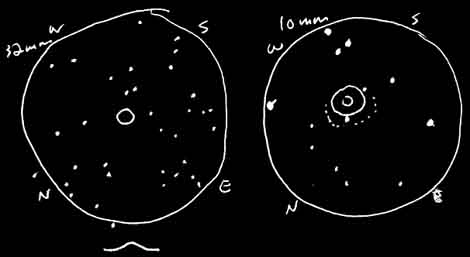
Observation Notes:
At 37X, this globular cluster is small, but still easily visible. I didn’t see any granularity at this magnification. The nucleus was circular and tight, but not stellar. At 120X, granularity was still hard to come by. About 7 or 8 stars were blinking in and out across the surface. The fall off in brightness seemed softest to the NE.
Factoids:
At a distance of 18 to 19,000 light years, M28 has a diameter of 60 light years. It was the second globular cluster that was discovered to contain a millisecond pulsar–this pulsar spins around its axis once every 11 milliseconds. M28 was discovered by Charles Messier in 1764.
| Subject | M28/NGC 6626 |
| Classification | Globular Cluster |
| Position | Sagittarius [RA: 18:24.5 / Dec: -24:52]* |
| Size* | 11.2′ |
| Brightness* | 6.8 |
| Date/Time | 10/14/04 – 8:05 PM |
| Observing Loc. | Flagstaff, AZ – Home |
| Instrument | Orion SVP 6LT Reflector (150 mm dia./1200 mm F/L) |
| Eyepieces/Mag. | 32 mm (37X), 10 mm (120X) |
| Seeing | 3/10 |
| Transparency | Mag 5.8 |
* Based on published data.